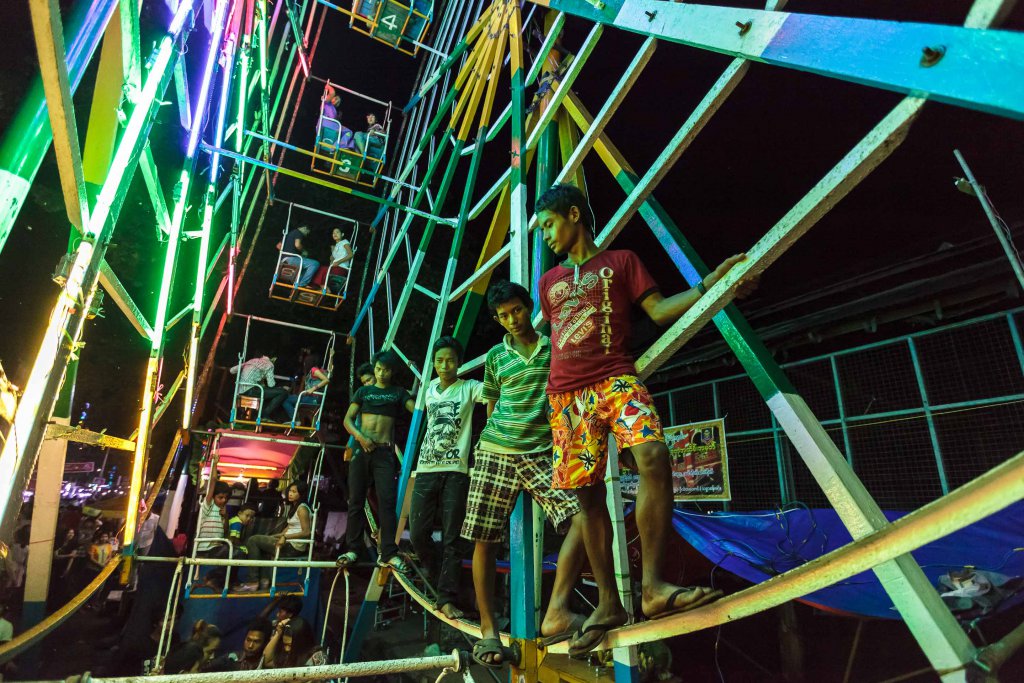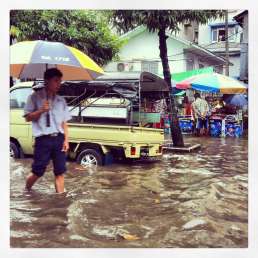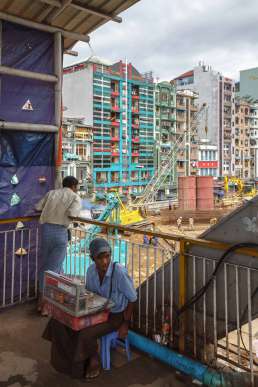A Troubled History, and Beyond
by Elliott Fox
While I was writing, I would often dwell on a curious illustration of Yangon, believed to be from around 1824. In strokes of black ink, you see the Sule Pagoda rising from nothing but swamp and trees. Incredibly, it sits on a small island. A simple footbridge leads to a modest town, population 8,000.
To my mind, the story of each building in this city starts with this question: why did the island vanish? Why was the pagoda robbed of its peaceful waters to stand among seven million human lives?
“It was a place for Buddhists, Christians, Hindus, Jews and Muslims, and traders from Baghdad to Glasgow”
A whirlwhind chronology (we offer a proper one) might go something like this: the British took charge in the 1850s. Yangon became Rangoon. By the 1930s, the docks greeted more immigrants than those of New York City. It was a place for Buddhists, Christians, Hindus, Jews and Muslims, and traders from Baghdad to Glasgow. Churches, temples, mosques, stupas, banks and shophouses stretched from the jetties to the Shwedagon. In other words, a colonial master plan was now a place of flesh, steel and brick: hot and bustling streets, in a tight pattern, wove around the lost island from the illustration—by then, a very British roundabout surrounded the Sule Pagoda.
The architecture from those high times was loud and bombastic. But with hindsight, even the loftiest British designs look tired, tragic and mistaken today: inside those vast buildings, with their lions (the High Court) or vaulting towers (the Secretariat) a handful of pink and sweaty men thought they could rule forever. Then came the Japanese and a war that shattered the city, prompting one of the largest human exoduses of modern history, as hundreds of thousands of Indian migrants fled west, by foot, clutching their belongings.
The greatest symbolic trauma in the country’s collective memory was a single day, 19 July 1947, when Aung San was shot and killed by jealous rivals inside the Secretariat. The man who embodied the spirit of independence was dead. It took place without him. In 1948, the Union Jack descended the Secretariat flagpole. A new flag, representing the Union of Burma, rose in its place.
Post-independence architecture evokes the hopes of a second boom in the 1950s. Buildings from those days are self-consciously stripped of colonial conceit, wanting to look resolutely modern—I particularly love the downtown cinemas, the Thamada or Shae Saung, whose façades have lost nothing of their optimism. But that boom never came. Myanmar, and the post-colonial world, were too fragile in the throes of the Cold War. So fragile, in fact, that Yangon was de facto isolated from the rest of the country for long stretches of civil war.
Then came 1962, and the dark days of Ne Win. Like poison ivy, barbed wire wrapped around hundreds of buildings. Much of it is still there today, the rusty blades adding yet more historical texture to those fading colonial façades.
Several decades of repression followed, rocked by landmark moments of revolt and bloodshed: 1974, 1988, 2007. The military regime mutated over the period. This led, in the eyes of the world, to an “opening-up” of the country in 2011. While change is palpable in Yangon, it isn’t so much anywhere else. For one, the army was at war with the country’s dozens of ethnic minority groups for more than 60 years. A draft national ceasefire was signed in April 2015, heralding—perhaps—a lasting peace in the future.
Yangon booms again today. Many pavements are still broken, yet along them, boardings promise gleaming new condos for the swelling international class. But the country’s politics remain complicated. Overtures towards democracy seem to lurch—and lurch only—in a fairer direction.
“This city is the shared legacy of tangled nations and kindred cultures”
And the city dreams again of global stature; many foreign governments and businesses are eyeing Myanmar’s resources. This must come with tangible benefits—better jobs, say, or better health services—for all residents, and not just those in the newest glass towers.
I say this because this book has taught me to read pain and injustice on many of the city’s most majestic façades. In their shadow, Yangon’s residents have shown courage and resilience in the face of upheaval, unforgivable violence and terrible natural disasters. This time around they, and Myanmar as a whole, deserve a better deal. Global actors should do business responsibly. They should heed the visible lessons of the past.
This city is the shared legacy of tangled nations and kindred cultures. In that sense, it is literally an example to the world: as Thant Myint-U points out in his writings, the expression “plural society” was coined to describe the exceptional mix of colonial Rangoon. And in our world, pluralism is often held to be a good thing in general, and a great thing in a global city. The question is whether, and how, Yangon can thrive and move beyond the darker memories for good. I hope the book helps explore this.
To put it another way: it was Clement Attlee, the British prime minister in 1947, who returned the keys to Myanmar’s future. But it was Winston Churchill who inadvertently captured Yangon’s tumultuous magic, so palpable as you—Burmese or foreigner—wander the streets.
“First we shape our buildings,” he once said. “Thereafter they shape us.”
The Road to Yangon
by Manuel Oka
Several years ago my interest in Myanmar started to grow. I was mainly intrigued by the stories of a country that seemed to have been almost forgotten by the world. What little knowledge I had only painted a rough picture of Myanmar: on the one hand, of a serene, deeply Buddhist society strewn with ancient temples and monks in red robes; and on the other hand, an autocratic regime with a strained relationship towards human rights and the international community. My interest remained private in nature for many years, fuelled mostly by the bucolic images of an apparently forgotten land that longed to be explored.
As Myanmar gradually started to open up, more stories would reach my ears that painted a wholly different picture. Especially intriguing were the descriptions of the former capital city, Yangon, that was said to exude a vibrancy not unlike that of Havana in its street life as well as its colourful streetscape. Soon, well-known international newspapers and TV stations started to cover the colonial heritage left behind by the British—largely untouched due to decades of international isolation. These media stories would usually highlight the Yangon Heritage Trust’s conservation efforts, illustrated with dilapidated and overgrown brick buildings. The journalists would then describe the struggles of combating urban decay, blaming a sluggish and negligent bureaucracy. As a cautionary tale, the audience was reminded of the fates of numerous other Asian cities that had once held a similar cultural heritage. Was a future of indistinct high-rises and mega malls now looming over Yangon, too?
Ben and I had previously collaborated fruitfully on a research project about urban architecture in Tokyo. When he told me about his first visit to Myanmar, I didn’t need much convincing. In our own way, we wanted to document this unique assortment of ancient temples, stately brick buildings and crowded tenements before the tides of urban and economic development could threaten them. As a regular visitor to Myanmar with some exposure to its history and politics, Elliott naturally completed the team.
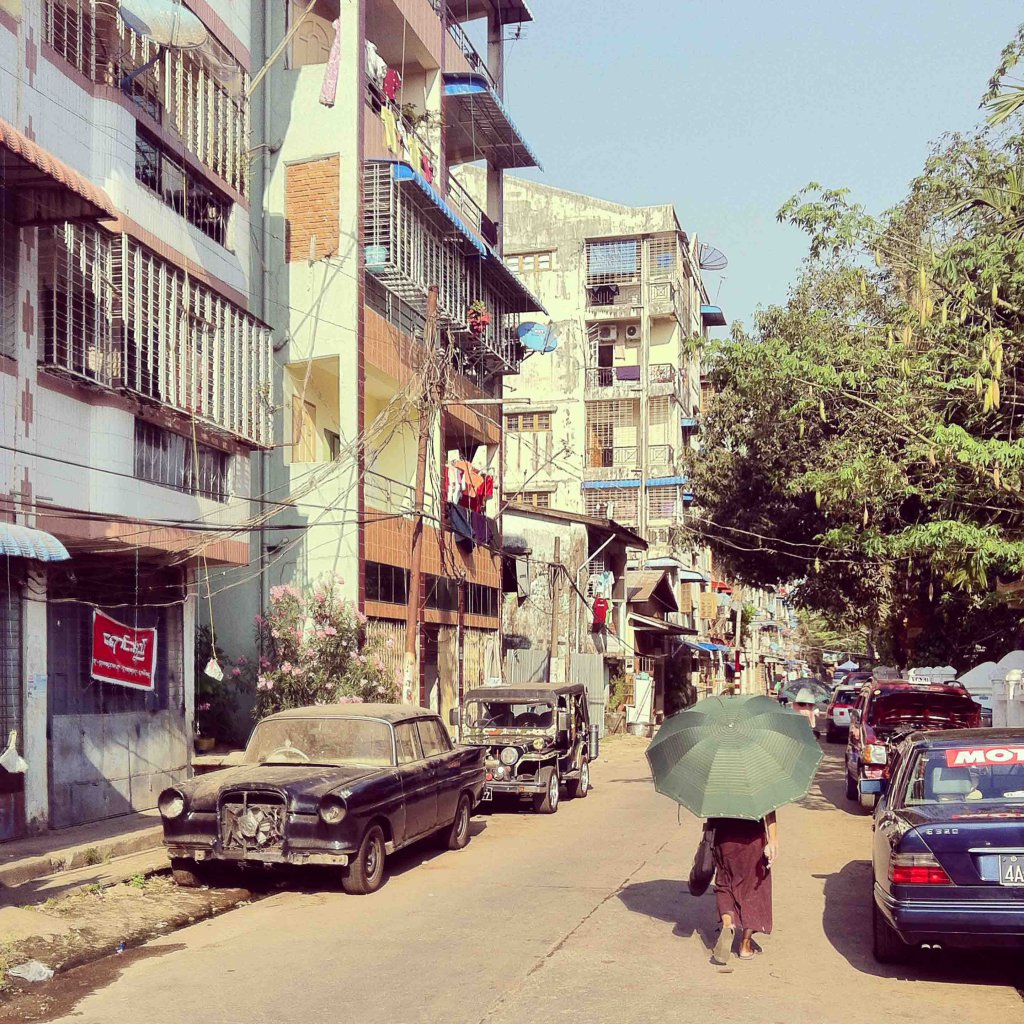
My first trip to Yangon quickly revealed that the city’s architectural scope extended far beyond what was left by the British Empire. I would often stumble upon arresting architecture from later decades. But trying to find relevant buildings in a city of seven million was—for lack of written resources such as this very book!—a daunting task. Information about individual buildings I had already discovered was often scarce, if available at all. Yangon, it seemed, was in dire need of an architectural digest.
“Soon after the break of daylight, traffic would swell to a stream of roaring metal that wouldn’t subside until well past sunset”
Research happened on the dusty (but also sometimes flooded) streets of Yangon and in the archives of scholarly libraries overseas. As the team’s photographer, my work consisted mostly of the former, which at times could be a laborious task. Even after the torrential monsoon rains had passed and the humidity became less oppressive, shooting hours were mostly limited to the mornings and late afternoons. Soon after the break of daylight, traffic would swell to a stream of roaring metal that wouldn’t subside until well past sunset. The midday sun would cast harsh shadows into the narrow downtown alleys, swallowing every detail. In wider areas, it was hard to escape the scorching sun. In the gentler hours of the day, just before sunrise and right after sunset, I became a feast for swarms of hungry mosquitoes.
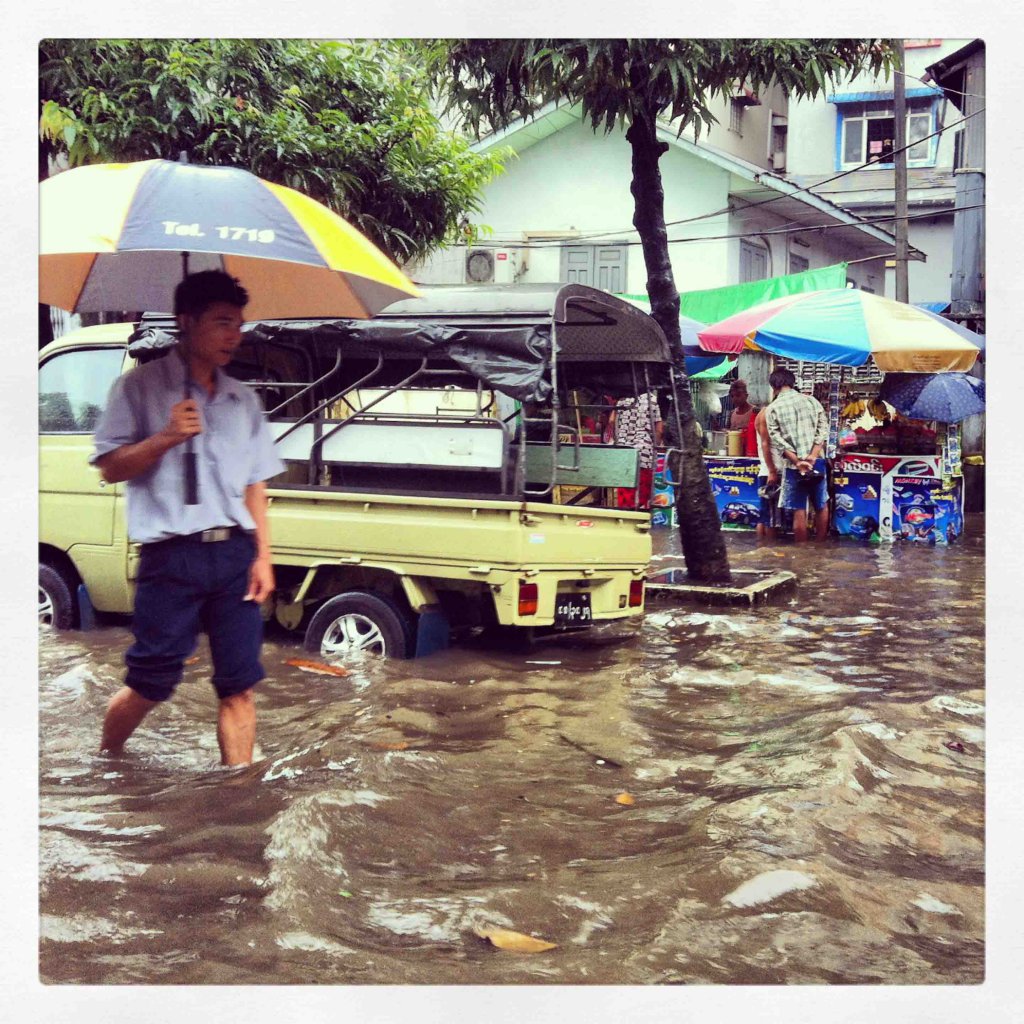
But these inconveniences pale in comparison to the kindness that I was met with. Access to many off-limits buildings only became possible after getting to know the right people. Personal conversations with architects and artists, but also with shopkeepers and taxi drivers, often revealed important bits of information or anecdotes that ended up in this book. Finally, an active social media community also contributed greatly to our research. I am lucky to have come away with many lasting friendships in another city that I can now call home.
Society and Space
by Ben Bansal
This guide presents 110 buildings around Yangon. Collectively they help the visitor—or resident—appreciate the built environment of a fast-changing city. Although we publish this book in DOM’s Architectural Guide series, we hope to attract a diverse range of readers, and not “just” architecture enthusiasts: this guide is for anyone who wishes to learn about Myanmar and its former capital. As just one of three authors of this book is an architect by training, it will become clear that the built environment is only a lens through which we look at the country’s and city’s historical, social and economic context.
For me, this project constitutes the culmination of a multi-year intellectual journey. I am a development economist by training, hence I tended to look at the world through the abstract and by approximation. A long stay in Tokyo changed this. As I walked the streets and remembered my classes on the Japanese economic miracle, I found its physical manifestations everywhere, in the many layers of the built environment, prompting my continued research at the interstice of society and space. In early 2013, I took on a month-long assignment in Yangon, researching the investment environment in this rapidly liberalising country. Fascinated by Myanmar’s history, the city had a profound impact on me. Traces of the past, far and near, were virtually everywhere. I was hungry for information that linked the many spaces to this most fascinating history. The idea for this book was born.
Of course, there are pitfalls to writing a guide about a city on the cusp of a new chapter in its—and Myanmar’s—history. Inevitably information will become out of date, perhaps faster than we expect. Some buildings will disappear. New ones will rise. Their uses will change. Some of our speculations may turn out wrong. Nonetheless, these are exciting times to write such a guide. In 10 to 20 years, much of this city will have mutated beyond recognition. We hope this book helps to record the sheer scale of Yangon’s transition at this moment in time.
“The architects—literally building a new country—taught us many lessons”
There are many recurring themes in this book. One is the cosmopolitanism of old Rangoon. Plenty of buildings around the city convey this, and many are featured in our book. Others, which we could not fit in, include the Chinese shophouses in Latha, or a building from the Sikh community—perhaps its Gurdwara on Thein Phyu Road. There are also many buildings we would have liked to show in our book but that are no longer standing. A Parsi fire temple near Mogul Street comes to mind. From this angle, a selection of merely 110 buildings falls way short of conveying the true richness of Yangon. To put this in perspective, a new list of notable buildings by the Yangon Heritage Trust (YHT) will reportedly contain more than 1,000 edifices around town.
When telling people that we were writing an architectural guide to Yangon, a typical reaction was to assume we were focusing on colonial buildings only. In fact, the most rewarding moments of research brought us closer to the city’s lesser-known, post-independence architecture. The architects—literally building a new country—taught us many lessons. We discovered the lives of Raglan Squire, Viktor Andreyev and Benjamin Polk, among the first foreign architects to work in independent Burma. Of equal if not greater significance, we learned about a small and impressive group of local architects. While U Tin was the most famous among them, U Tun Than and U Kyaw Min left behind important legacies within the cityscape as well.
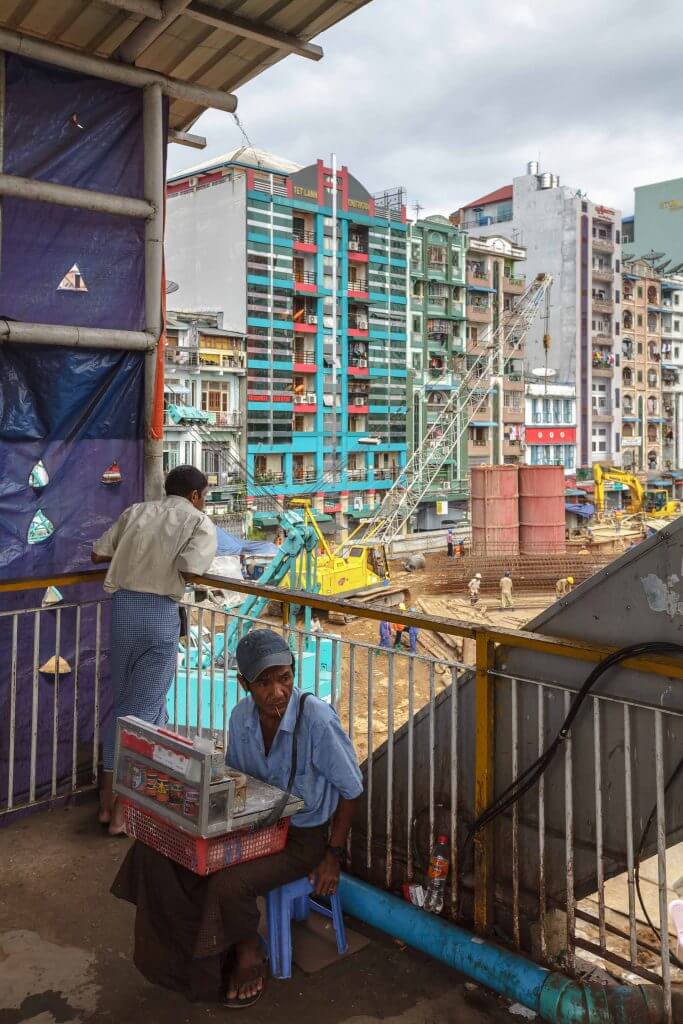
We hope to provide our readers with more than just information about the buildings. The book contains six thematic chapters, or “insets”, covering topics crucial to understanding Yangon’s built environment. They make lateral connections that help to place the buildings in a richer context. They may guide thematic explorations in a city that, in many respects, remains underexplored. Often, reliable information had to come not from within Yangon but from libraries abroad. It can only be hoped that a stronger academic community in Myanmar will soon enjoy greater freedom to explore the urban environment past, present and future. Besides a timeline highlighting the most notable dates and events of Yangon and Myanmar’s history, we also included the five favourite buildings of several personalities with deep connections to the city, to add a more personal layer to the book.
We deliberately avoided using old archival photos. For one, we hope that our text builds vivid-enough bridges to the past. But we also wanted the visuals to focus readers on the here and now—and consider Yangon’s future too. There are already books that transport you to the days of old Rangoon, and we could not aspire to compete with them (see Bibliography). We only made a couple of exceptions. A 1909 map of Rangoon shows both the continuities and the drastic changes that the city has experienced over the past century. Besides some photos taken by German photographer Adolphe Klier, we also show some snaps from travellers who came through the city between the 1970s and 1980s. While more recent than the black-and-white images of the colonial period, we feel these times are perhaps the most forgotten of all in Myanmar’s modern history.

